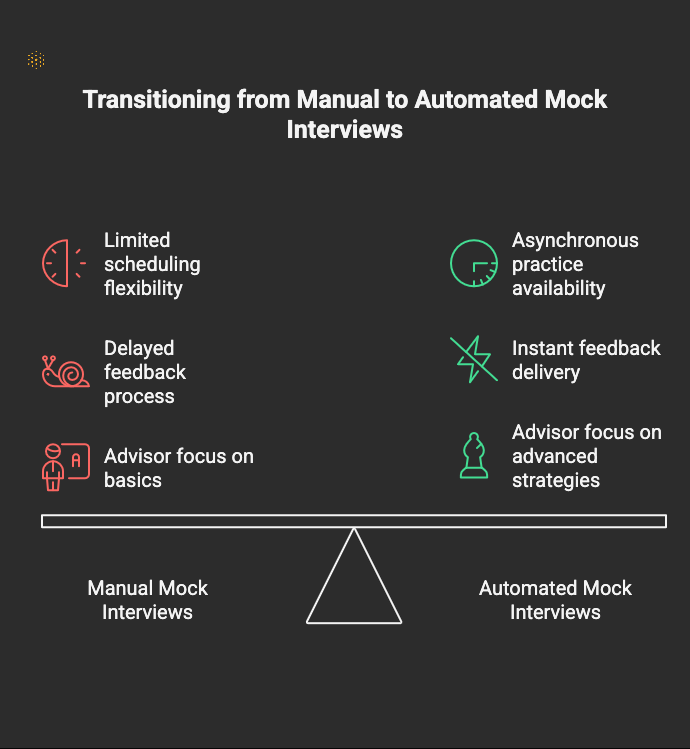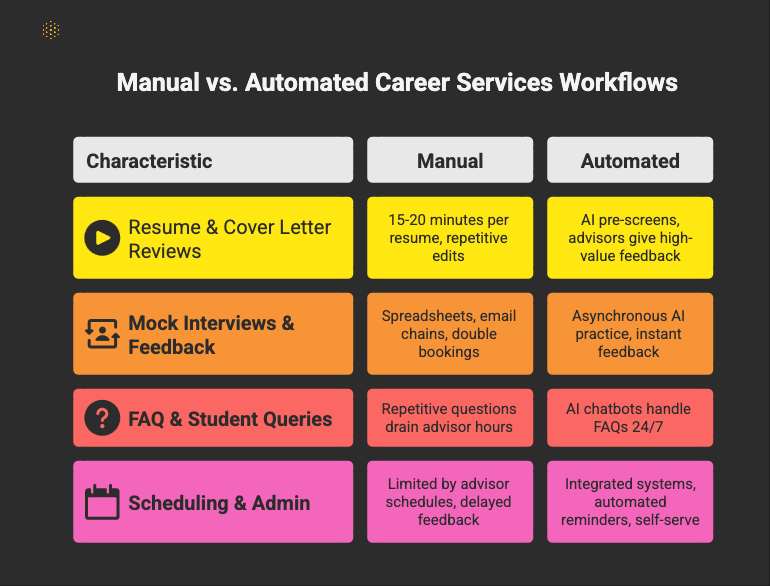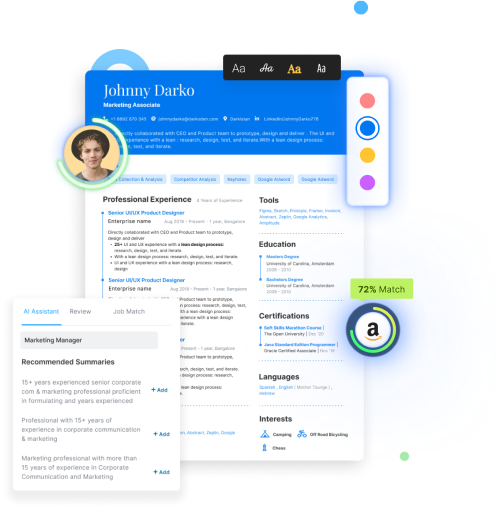Which career center workflows should be automated to free staff for higher-value coaching?
Automate resume and cover letter reviews, AI mock interview practice, FAQ responses via assistants, and integrated scheduling to cut busywork. Advisors then focus on strategic coaching, equity outreach, and employer partnerships.
Leadership wants proof of impact. Employers want job-ready talent. Students want support anytime, anywhere.
Career centers want all three - but are stuck in outdated workflows.
Staff are stretched thin, with 40.8% of advisors reporting weekly burnout.
Meanwhile, based on a NACE survey, nearly 80% of career professionals already see AI as the answer, and almost half point to its cost-saving potential.
The issue isn’t staffing - it’s process. Too many hours vanish to resume line edits, inbox FAQs, and scheduling spreadsheets instead of the coaching that drives real outcomes.
The fix is clear: let AI and automation handle the repetitive work so staff can focus on preparing students for success.
Here’s how 4 of the most time-consuming workflows transform when career centers shift from manual to strategic and tailored automation.
Workflow 1: Resume & Cover Letter Reviews
Before (Manual):
Advisors spend 15-20 minutes per student resume correcting formatting, bullet structure, and missing keywords. With thousands of students, this adds up to weeks of staff time spent on repetitive edits rather than coaching.
After (Automated):
AI-powered tools pre-screen resumes and cover letters for structure, formatting, keyword alignment, and ATS readiness. Advisors then step in only for higher-value feedback: tailoring for specific roles, positioning transferable skills, or refining narratives.
Impact/ROI:
- 90% faster turnaround (Tech Elevator cut reviews from weeks to days).
- Rasmussen University: 3,000+ resumes created in just nine months, freeing advisors to focus on strategy.
Also Read: What are the top 5 career services benchmarks every center must track?
Workflow 2: Mock Interviews & Feedback
Before (Manual):
Mock interviews are typically one-on-one, limited by advisor schedules. Students often wait weeks for appointments, and feedback is constrained by staff availability.
After (Automated):
Students practice asynchronously on AI interview platforms, receiving instant feedback on tone, structure, and even posture. Advisors can then use meeting time for advanced strategies: handling behavioral questions, tailoring responses for niche industries, or networking guidance.
Impact/ROI:
- Shawnee State University: 30 asynchronous mock interviews completed during a pilot, saving 40+ advisor hours.
- Students enter real interviews with more confidence, while staff avoid repetitive “intro-level” prep.
Also Read: How is Hiration better than Big Interview?

Workflow 3: FAQ & Student Queries
Before (Manual):
Advisors’ inboxes overflow with repetitive questions: Where’s the job portal? How do I register for the fair? What should I wear to an interview? Answering each individually drains hours and adds little value.
After (Automated):
AI-powered career assistants like chatbots handle FAQs around the clock. Students receive instant answers to common questions, while advisors only step in for complex, personalized queries.
Impact/ROI:
- The UK’s Association of Graduate Careers Advisory Services (AGCAS) found that over half of student inquiries are basic questions - a perfect fit for automation.
- Drives adoption of underused resources: automated assistants don’t just answer questions, they also guide students toward workshops, portals, and career modules they may otherwise overlook, boosting overall engagement with existing services.
- Equity impact: first-gen and working students get support on their schedule, not office hours.
Also Read: Why are career services using outdated career tools?
Workflow 4: Scheduling & Administrative Logistics
Before (Manual):
Appointments and events are managed via spreadsheets, email chains, and calendar juggling. This creates bottlenecks, double bookings, and missed reminders, frustrating both staff and students. In fact, faculty and staff in higher education spend 30-40% of their time on administrative tasks, with scheduling being one of the most significant burdens.
After (Automated):
Integrated scheduling systems handle bookings, send automated reminders, and sync with institutional calendars. Students self-serve appointments, while advisors focus on preparation instead of logistics.
Impact/ROI:
- Reduces admin time by up to 40%.
- Automated nudges boost student show-up rates, ensuring time invested in programming pays off.
Also Read: How does counselor burnout reveal a career center system that’s no longer working?
Before vs. After: Career Services Workflows
Here’s what the shift from manual → automated looks like in practice:

Putting It All Together: Smarter Workflows, Higher Impact
The common theme is clear: automation doesn’t replace advisors, it repositions them. Instead of burning time on clerical work, staff can focus on:
- Building employer partnerships
- Coaching students through high-stakes interviews
- Designing equity-focused outreach
- Measuring and improving career outcomes
And this isn’t hypothetical - colleges and organizations using Hiration have already seen what this shift makes possible:
- Rasmussen University: Over 3,000 resumes were created in the first 9 months.
- Shawnee State University: saved over 40 hours of preparation time while achieving 100% utilization of all key Hiration features, which helped students create 127 resumes, 67 cover letters, and complete 30 mock interviews.
- MUST Ministries: Supported underserved learners with 24/7 career tools, leading to a 93% increase in job placements, rising from 1,206 to 2,331 jobs.
Hiration doesn’t just save staff time - it empowers career centers to scale their impact, improve equity, and deliver measurable student success.
Join the 100+ institutions like NYU Stern and SFSU, already using Hiration. Book a demo today - with a free pilot and no setup fees.
Frequently Asked Questions
-
What career services workflows should you automate?
Automate resume and cover letter reviews, mock interviews and feedback, FAQ and student queries, and scheduling and administrative logistics. This shifts time from repetitive tasks to higher-value coaching.
-
How does automating resume and cover letter reviews work?
AI-powered tools pre-screen resumes and cover letters for structure, formatting, keyword alignment, and ATS readiness, then advisors deliver higher-value feedback. Programs report 90% faster turnaround.
-
What impact does automating mock interviews have?
Students practice asynchronously on AI interview platforms and receive instant feedback on tone, structure, and even posture. A pilot completed 30 asynchronous mock interviews, saving 40+ advisor hours.
-
How can AI handle FAQ and student queries?
AI-powered career assistants like chatbots handle FAQs around the clock, giving you instant answers to common questions. Over half of student inquiries are basic questions, making them a strong fit for automation.
-
How does automating scheduling reduce administrative burden?
Integrated scheduling systems manage bookings, send automated reminders, and sync with institutional calendars so students self-serve appointments. Faculty and staff spend 30-40% of their time on administrative tasks, and automation reduces admin time by up to 40%.
-
What common manual processes waste staff time in career services?
Too many hours vanish to resume line edits, inbox FAQs, and scheduling spreadsheets instead of the coaching that drives real outcomes. Staff are stretched thin, with 40.8% of advisors reporting weekly burnout.
-
How does automation change advisors’ roles?
Automation doesn’t replace advisors, it repositions them. You focus on building employer partnerships, coaching students through high-stakes interviews, designing equity-focused outreach, and measuring and improving career outcomes.
-
What measurable results have institutions seen after adopting these tools?
Over 3,000 resumes were created in the first 9 months. Shawnee State University saved over 40 hours while achieving 100% utilization, helping students create 127 resumes, 67 cover letters, and complete 30 mock interviews.
-
What evidence shows AI adoption is rising in career services?
Nearly 80% of career professionals already see AI as the answer, and almost half point to its cost-saving potential. This indicates broad support for adopting AI in career services.
-
What changes when you move from manual to automated career workflows?
Let AI and automation handle the repetitive work so staff can focus on preparing students for success. Advisors then concentrate on coaching that drives real outcomes.



